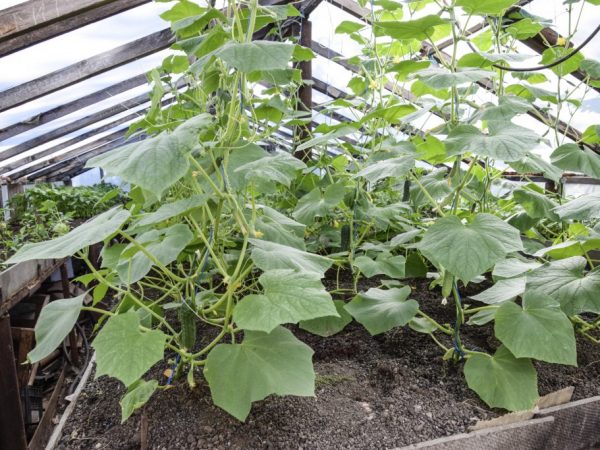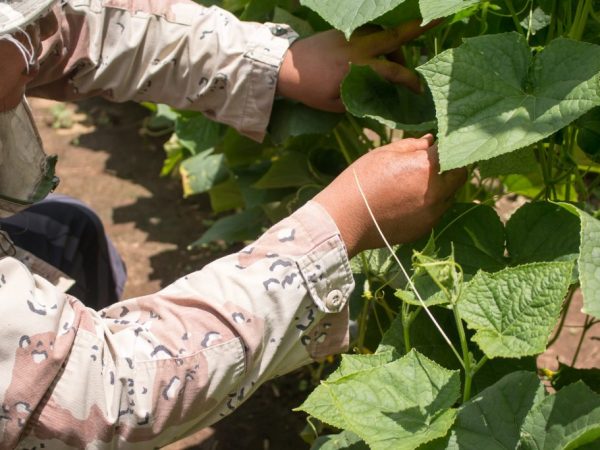Planting and growing cucumbers in a greenhouse
Planting cucumbers in a greenhouse is a good way to grow early fruits and get a bountiful harvest, regardless of climatic conditions. It is quite possible to plant seeds or seedlings of cucumbers in a greenhouse, planting in spring, autumn and even winter. Consider the principles of proper cultivation of cucumbers in unheated and heated greenhouses.

Planting and growing cucumbers in a greenhouse
Requirements for the device of the greenhouse
- To make the frame of the greenhouse, wood or metal is used, but it is best to make the frame from plastic (it will not rot or rust). It is better to choose glass as a coating, although polycarbonate material and the well-known budgetary polyethylene film are considered good options.
- For the installation of greenhouses, bright places are chosen that quickly warm up with the arrival of spring.
- Spring planting of cucumbers in a greenhouse requires special soil preparation from the fall. The top layer of soil (4-6 cm) must be removed, since it is in it that microorganisms are located that can cause diseases of seedlings. The wooden parts of the greenhouse and the soil itself are treated with a solution of copper sulfate, and then fertilized with manure, phosphorus and potash fertilizers, sprinkled with lime (300-400 g per 1 sq. M) and carefully dug to the depth of a shovel.
- In the spring, before planting the seeds, the soil is properly prepared again: fertilized with manure and forming ridges according to the scheme: width - about 1 m, height - 20-30 cm.It is necessary to make passes between the ridges (about 60 cm) in order to be able to care for plants and harvest.
- The layout of the ridges depends on the size of the greenhouse. So, for greenhouses with a width of 2-3 m, it is convenient to choose a planting scheme with two ridges on the sides and one path between them. For greenhouses with a width of 4 m, you can make 3 or more ridges with several passes.
- After the ridges are formed, a trellis of wire is pulled over them, to which cucumbers are subsequently tied.
Seed method
In the southern regions, seeds are sown directly into the greenhouse in the 20th of April, in colder ones - in May, when the air temperature rises to 18 ° C. (If it is possible to supplement the lighting and heat the greenhouse, sowing seeds is permissible at any time.) Sowing is carried out in well-fertilized and watered soil, due to which the heat required for seed germination is generated in the soil. Instead of manure, other organic matter is often used, for example, fallen leaves or sawdust.
For 1 sq. m it is recommended to plant no more than 4 plants, otherwise the excessive density will negatively affect the yield.
They make holes 1-1.5 cm deep and sow 1 or 2 grains in them, depending on the confidence in the germination of seeds. (If both seeds germinate, a stronger seedling is left, and the second is cut at the very root). From above, the crops are covered with a thin layer of seedling mixture.
Preliminary preparation
Some gardeners believe that additional seed preparation is not necessary when the soil is well manured, but others prefer to work with the seed to increase germination. A month before planting, the seeds are placed near the battery to warm them up thoroughly. After 3 weeks, they are immersed in salt water to remove the bad ones - those that float. Then the seeds are soaked for a quarter of an hour in a manganese solution for disinfection, and then washed and kept in a nutrient solution (one of the options is a mixture of aloe juice and a solution of wood ash).
Seedling method

Seedlings need to be prepared for planting in a greenhouse
Many people prefer to germinate seeds at home, and then plant the finished seedlings in a greenhouse. Whenever possible, when sowing, the seeds should be planted in separate containers (peat pots, eggshells, etc.). The seeds are preliminarily prepared by heating, disinfecting and soaking in the same way as described above. A suitable seedling soil is a mixture of peat, sawdust, compost or rotted manure, turf. In addition, a special seedling substrate can be purchased ready-made in the store.
The seeds are planted to a depth of 1.5-2 cm, watered with warm water and covered with plastic wrap. Containers with seedlings are placed in a well-lit, warm place, where the temperature is maintained at 25-30 ° C and, if necessary, the crops are supplemented. With the appearance of sprouts, the temperature is lowered to 20 ° C and the film is removed. When the seedlings have 3-4 leaves, they can be planted in a greenhouse.
Hardening and planting seeds
Before planting in a greenhouse, seedlings must be hardened. For 1-2 weeks, the temperature for the seedlings is set: during the day - 17-18 ° С, at night - 13-14 ° С. Seedlings are planted in the ground together with an earthen clod. For this, holes of the appropriate size are formed, treated with a manganese solution and poured with warm water. The seedling is placed in such a way that the earthen lump is a couple of centimeters higher than the edge of the hole.
Autumn and winter planting
To get a harvest in the fall, it is advised to plant cucumbers in a greenhouse at the very end of August, while the soil is still warm enough. Usually this is done by the sowing method, however, it is permissible to sow seeds for germination at home, and plant ready-made seedlings in a greenhouse in early October. For autumn planting, you should choose a late-ripening variety that is resistant to sudden changes in temperature.
For winter planting, you will need a heated greenhouse and additional lighting.
In addition, self-pollinated varieties should be chosen for the winter cultivation of cucumbers, since it is not necessary to rely on bees in the cold season.
It is recommended to sow seeds in early December to get fresh cucumbers in the second half of February.
Watering and feeding
Water the cucumbers very carefully so that the water moistens the ground and does not touch the leaf (to avoid burns). While the plants are not blooming, watered once every 5 days, after the formation of flowers - once every 3 days. If the weather is hot, you need to water often, ideally every other day.
Watering should be done in the morning, with settled warm water. Growing cucumbers in a greenhouse in autumn and winter requires a different watering scheme: in the fall, it is enough to water the plants once a week, and closer to winter and in December-January - twice a month.
If the leaf on greenhouse cucumbers turns yellow, and the stems become lethargic and small, the plants lack nitrogen. With a lack of phosphorus, the leaf turns blue, which soon dries to blackness. If the edges of the leaves turn brown and the fruits become hooked, the plants lack potassium. In order not to encounter manifestations of a lack of trace elements at all, you can make it a rule to carry out a complex feeding of cucumbers every 10 days, starting from the fruiting period (3-4 weeks after the seedlings are planted).
Helpful hints
- When choosing a variety for a greenhouse, take into account not only the desired ripening time and the method of pollination, but also the adaptability of the variety to a certain climate. So, frost-resistant varieties are suitable for cold regions: Altai, Miranda, Amur and others. In regions with hot summers, it is especially important to choose a variety that is resistant to high temperatures (Tiburon, Lyutoyar, etc.), otherwise the cucumbers will burn in hot July.
- To germinate seeds sown directly into the greenhouse, it is very important to maintain a high temperature of the soil and air. To do this, along with the preliminary fertilization of the soil, individual shelters can be made for each seed using an ordinary plastic bottle, cut and stuck into the ground.
- Seeds can be pre-germinated before planting. Most often, boric acid is used for this (you can take another growth stimulant), in which the seeds are soaked for 12-14 hours. Then they are transferred to a damp gauze and placed in a warm place (about 22 ° C). When the seeds germinate, they can be planted in the ground: directly in the greenhouse or in pots for seedlings.
- On the beds with cucumbers, do not leave the remains of weeds, fallen leaves and other debris, as this attracts pests and provokes diseases.
- From a lack of moisture on cucumbers, a tick may appear, which can nullify all the results of cultivation. Measures to combat it - thorough loosening of the soil, timely watering, processing of leaves with tincture of onion peels, fumigation of the greenhouse with sulfur.
- If plants are planted in cold soil or watered with too cold water, they can develop a fungal infection, the so-called root rot or root rot. Unfortunately, it cannot be cured: severely affected bushes must be removed from the greenhouse in order to protect other plants.
- Ripe cucumbers should be harvested regularly to stimulate vigorous new fruit growth. Harvesting can be done in the morning or in the evening, every 2 days, or better - every day.


